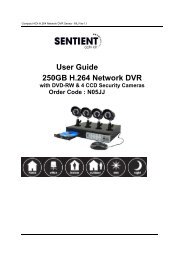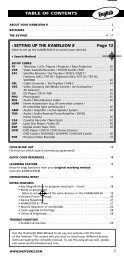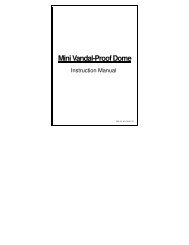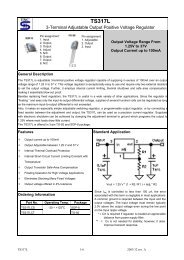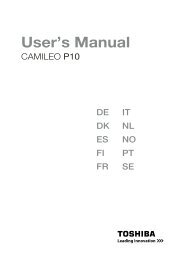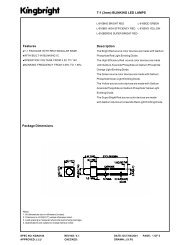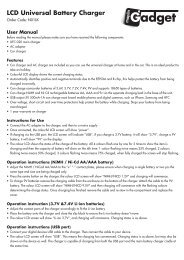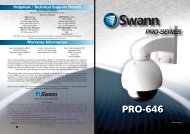EAPA AMPLIFIERS - Maplin Electronics
EAPA AMPLIFIERS - Maplin Electronics
EAPA AMPLIFIERS - Maplin Electronics
Create successful ePaper yourself
Turn your PDF publications into a flip-book with our unique Google optimized e-Paper software.
SETTING THE GAIN<br />
After completing the installation, follow these steps to set the Gain Control and then perform the<br />
Final System Checks.<br />
1. Turn the Gain Control all the way counter-clockwise.<br />
2. Turn the vehicle’s Ignition Switch to the ON position. Then turn the ON/OFF<br />
Switch on the source unit to the ON position. Set all Tone or Equalization Controls to “flat” positions<br />
and turn Loudness off.<br />
3. Play a CD or Tape and set the Volume Control at 75% of full level.<br />
NOTE: If the system uses an equalizer set all frequency controls to the “flat” position.<br />
4. Slowly increase the Gain Control. Stop when you hear a slight distortion of audio.<br />
SETTING THE CROSSOVER<br />
1. Using the X-Over Mode Switch, select the desired mode: LP for Low Pass, HP for High Pass or<br />
-7-<br />
OFF for Full Range.<br />
2. Using the Freq (Hz) Selection Control, select the desired frequency.<br />
SETTING THE BASS BOOST<br />
1. Initially set the Bass Boost control to its OFF position.<br />
2. Listen to a variety of music styles (e.g., Rock, Rap, etc.) and switch the Bass Boost control ON<br />
until a noticeable increase in low bass response is realized.<br />
CAUTION: If you hear a “pop” (due to speaker over-excursion) adjust switch to lower the Bass<br />
Boost to prevent speaker damage.<br />
FINAL SYSTEM CHECKS<br />
1. Start the engine and turn on the source unit. After a two-second delay, slowly increase the volume<br />
control and listen to the audio. If you hear any noise, static, distortion or no sound at all, check the<br />
connections, and also refer to troubleshooting section below. Depending on your system design, the<br />
levels may become quite loud even at low volume control settings. Until you get an “audio feel” of<br />
the system’s power, use care when adjusting controls.<br />
2. Turn the balance controls to their extreme positions and listen to the results. Audio output should<br />
match control settings (audio from the left speaker when balance is left).<br />
3. Increase the volume and verify that the amplifier reproduces audio (at full frequencies) without<br />
distortion. If you hear distortion, check the connections and verify that the gain control is set correctly.<br />
Another possibility is damaged speakers or underpowered speakers. Once again refer to<br />
troubleshooting section for additional help.<br />
TROUBLESHOOTING<br />
PROBLEM POSSIBLE CAUSE SOLUTION<br />
AUDIO CYCLES<br />
ON AND OFF<br />
NO AUDIO<br />
THERMAL PROTECTION<br />
CIRCUITS ARE SHUTTING<br />
AMPLIFIER OFF<br />
LOW OR NO REMOTE<br />
TURN-ON VOLTAGE<br />
CHECK LOCATION FOR ADEQUATE<br />
VENTILATION; CONSULT AN AUTHORIZED<br />
CLARION AUDIO DEALER.<br />
CHECK REMOTE CONNECTIONS AT AMPLIFIER<br />
AND SOURCE UNIT.<br />
BLOWN AMPLIFIER FUSE REPLACE WITH NEW FAST-BLOW FUSE (SAME<br />
RATING).<br />
POWER WIRES NOT<br />
CHECK BATTERY AND GROUND WIRING AT<br />
CONNECTED<br />
AMPLIFIER; ALSO CHECK BATTERY<br />
CONNECTIONS.<br />
SPEAKER LEADS SHORTED CHECK SPEAKER CONTINUITY TO GROUND, IT<br />
SHOULD NOT SHOW A COMMON GROUND.<br />
SPEAKERS NOT<br />
CHECK SPEAKER CONNECTIONS AT AMPLIFIER,<br />
CONNECTED OR ARE<br />
BLOWN<br />
MEASURE COIL IMPEDANCE.<br />
WHINING OR AMPLIFIER IS PICKING UP TURN DOWN INPUT GAIN AND MOVE AUDIO<br />
TICKING NOISE ALTERNATION NOISE OR CABLES AWAY FROM POWER WIRES. CHECK<br />
IN THE AUDIO RADIATED NOISE<br />
POWER AND GROUND CONNECTIONS ON<br />
WITH ENGINE<br />
AMPLIFIER AND INSTALL AN IN-LINE NOISE<br />
ON.<br />
FILTER ON SOURCE UNIT’S POWER WIRE.<br />
ALSO CHECK THE ALTERNATOR AND /OR<br />
VOLTAGE. TEST FOR WEAK BATTERY OR ADD<br />
WATER TO BATTERY.<br />
DISTORTED GAIN IS NOT SET<br />
REVIEW SETTING GAIN; INSPECT EACH<br />
AUDIO.<br />
PROPERLY, OR DAMAGED SPEAKER CONE FOR SIGNS OF DAMAGE (I.E.,<br />
SPEAKER CONES<br />
FROZEN CONE, BURNING SMELL, ETC.)<br />
AMPLIFIER FUSE INCORRECT WIRING OR REVIEW INSTALLATION AND CHECK ALL<br />
KEEPS BLOWING SHORT CIRCUIT<br />
-8-<br />
WIRING CONNECTION.



